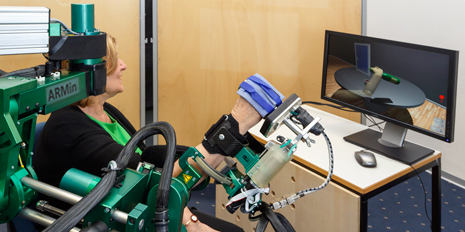Increased mobility thanks to robotic rehab

After a stroke, patients often struggle with persistent paresis. ETH researchers examined whether robot-assisted therapy can help stroke patients. This form of therapy proved successful particularly with the most severely affected persons with arm paresis.
The survivors of a stroke often struggle with persistent loss of function of the central nervous system. Around the world strokes are one of the most frequent causes of paresis. Physiotherapy or occupational therapy can restore a certain degree of mobility. However, a patient with severe paresis, for instance of an arm, can only recover limited function through these therapeutic exercises.
A new study by the research team of Robert Riener, Professor in the Sensory-Motor Systems Lab at ETH Zurich, raises fresh hope. The researchers compared the progress of patients with arm paresis in two different forms of therapy: firstly conventional therapy in which patients underwent classical training with a physiotherapist or occupational therapist, and secondly therapy in which a robot aided arm movements during training. Their study showed that the robot-assisted therapy leads on average to slightly better results than the conventional therapy.
Pouring simulated water
"On average the difference to the conventional therapy was small but patients in particular who had more severe paresis made far greater progress with the help of the robot", explains Riener. One reason could be that the robot can be adjusted to the individual patient. It assists arm movements, which means that even patients with severe paresis can carry out the exercises efficiently. The robot also enables playful training of activities of daily living (ADLs) via a computer simulation displayed on a screen. For instance, patients can take their time to practice pouring water from a jug into a glass without actually spilling anything.
Half of the 77 test persons were given the conventional and the other half the robot-assisted therapy. They each had three therapy sessions a week over eight weeks. Before, during and after this period an independent person regularly assessed the arm mobility of the test persons using various, established scoring systems (the primary end point was the Fugl-Meyer test) without knowing which form of therapy they had received. Furthermore, the researchers limited the selection of test persons to patients who had suffered a stroke more than six months previously in order to rule out any falsification of the results by spontaneous healing.
Breaking through the plateau
Roughly six months after a stroke most patients reach a chronic stage despite therapy in which further treatment would not restore hardly any additional mobility. Verena Klamroth, Senior Scientist with Riener and the main author of the study, said that overcoming this plateau was a major challenge for clinical research. "The fact that we have achieved this with the help of the robot is wonderful and gives rise to hope." The study was published recently in the medical journal The Lancet Neurology.
Comparison revealed that the robotic therapy produced better results in terms of sensory-motor function, but conventional therapy in terms of building strength. The researchers do, however, see a way of overcoming this shortcoming of robotic therapy in future. If patients could carry out the exercises in a robot against adjustable resistance, then strength building would probably improve as well which, in turn, would lead to greater mobility.
Independent training
An advantage of the therapy robot is not just that this form of therapy is possible for every degree of paresis but also that the patients can train independently, perhaps one day even at home, says Riener. The robot not only supports movement but also motivates the patient via computer game elements. Thanks to these game-like elements patients repeat the exercises more often and the researchers felt that this could be one of the advantages of robotic therapy.
A certain degree of caution should be exercised regarding the results as a blind control, the norm for placebo-controlled clinical trials, was not possible in this case according to Klamroth. Patients generally tend to respond more to a novel than to a long-established form of therapy. Nevertheless, the researchers see great potential for robot-assisted therapy. "The fact that even the most severely afflicted stroke patients now have a chance of therapy is really completely innovatory", says Klamroth. The major potential of this new form of therapy would now have to be examined in further studies over longer periods with more test parameters and in larger groups of patients with varying degrees of paresis.
More information: Klamroth-Marganska V, Blanco J, Campen K, Curt A, Dietz V, Ettlin T, Felder M, Fellinghauer B, Guidali M, Kollmar A, Luft A, Nef T, Schuster-Amft C, Stahel W, Riener R: Three-dimensional, task-specific robot therapy of the arm after stroke: a multicentre, parallel-group randomised trial. The Lancet Neurology, 27 December, 2013. DOI: 10.1016/S1474-4422(13)70305-3












